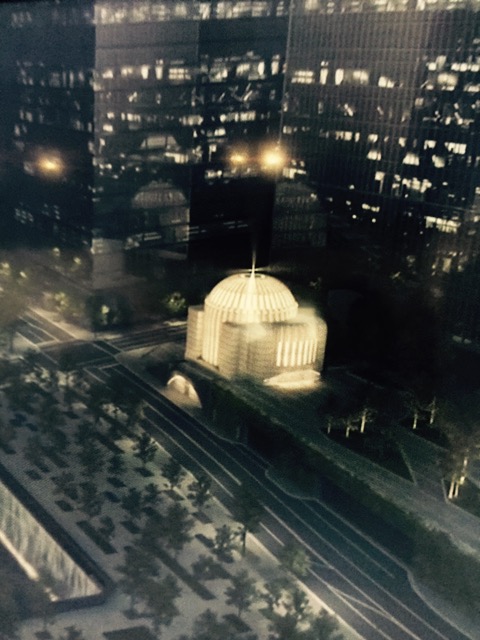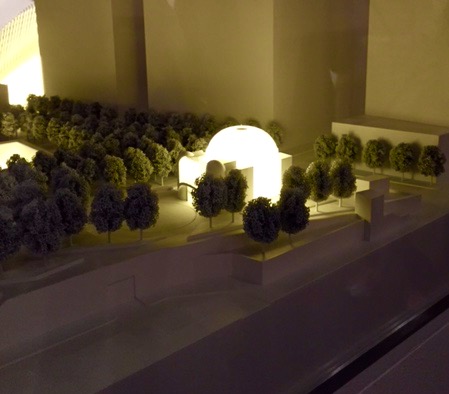Inspired by visiting the churches in Patmos while sailing in the Greek islands, Spanish architect Santiago Calatrava did not hesitate to submit his design for the building of the St. Nicholas Orthodox Church at the World Trade Center.
He visited many churches, and notably Aghia Sophia and the Church of the Holy Saviour in Chora (both in Istanbul) and made thousands of sketches before perfecting his proposal. This was selected from over a dozen others to replace a 19th-century building that was destroyed by falling debris and building parts from World Trade Center Tower Two during the 9/11 attacks in 2001. The Greek Orthodox Archdiocese had to negotiate hard with the Port Authority to have the church rebuilt, and is funding part of the project.
The domed structure will be partly clad in a translucent skin, made of thin stone and laminated glass, which will allow it to glow softly from the inside at night. A small white flame beneath the skyscrapers.
The project is being presented in an exhibition at the Benaki Museum. At the preview, looking at the maquettes and the original sketches that made up the exhibition, one could sense the church would provide an ideal counterpoint to the plaza’s twin reflecting pools.
Although St. Nicholas will function as a Greek Orthodox Church, it will also be open to anyone as a shrine and spiritual beacon overlooking the Ground Zero memorial Plaza. It is designed to be a place where people of every belief will be inspired to go in and light a memorial candle – even people who do not practice any religion.
The September 11 terrorist attack in the name of Islam gave rise to a discussion about the role of religion as a weapon of fanaticism. The fact that a Catholic architect designed a contemporary Byzantine church inspired by structures that were used also as Muslim mosques can only add a note of optimism and hope.
In my mind, there is also a historical connection of this idea with Constantine the Great, a Roman Emperor who later converted to Christianity and built Constantinople. In 313 A.D. he signed the Edict of Milan, concerning religious tolerance, which stopped the persecution of Christians. A small excerpt: ‘And thus by this wholesome counsel and most upright provision we thought to arrange that no one whatsoever should be denied the opportunity to give his heart to the observance of the Christian religion, of that religion which he should think best for himself, so that the Supreme Deity, to whose worship we freely yield our hearts may show in all things His usual favor and benevolence.’
Calatrava’s work is known for courting controversy. As well as supremely talented, he is perceived as vainglorious, designing meta-modern Parthenons that will secure his place in the Pantheon of architecture. His projects are often plagued by delays and spiraling costs. This particular design has been criticized by many as being ‘cold’, ‘like a pumpkin sitting in a box’, ‘more like a museum than a church’ and, worse, ‘like a mausoleum’. It is certainly not as welcoming inside as a traditional Byzantine church with its gold and red icons. In the context of the specific site, however, I personally found it awe-inspiring and very apt.
I’d be curious to know what everyone else thinks.
Below is a short video. The quality is mediocre, since I recorded it on my phone. But it shows a fascinating insight into Calatrava’s thought process as his design evolved.
Duration of the exhibition:
24/09/2015 – 25/10/2015
Venue:
Athens Benaki Museum
Main Building





Thanks for sharing this. I will unfortunately miss the exhibition and your post is helping me visualize it, with great perspective added!
I personally love Calatrava’s work, the most exciting being the Museum of Art in Milwaukee, which looks like great white bird emerging from the lake or a galley setting sail. I love his idea of the Greek church glowing in the night, it will be a fabulous addition to the new development of Ground Zero. It will certainly attract more attention than old St. Nicholas church; few non-parishioners had ever noticed it before.
I hope that the interior will end up giving a bit of the warmth of our traditional churches. Last Easter, being unable to come to Greece, i followed the holy week services in the modern church in Chambésy, Geneva. I was shocked by the modernity and coldness of the church, which detracted from my appreciation of the service. But, when the culminating moments of the Holy Friday and Saturday masses came, I felt a spirituality which is often lacking in our local services. This being the only Greek Orthodox church of Geneva, the priests made the Christos Anesti is Greek, French, Arabic, Aramaic and Romanian. It was so powerful to take notice of so many different people of related faiths around us.
As for Constantine, I do not share this idealized rendering of his legalizing Christianity. The ruthless and brutal pursuit of power by his mom and him found a great tool in Christianity and in dislocating the capital from Rome. Having said this, hats off to him for his mastery of imagery and propaganda!
LikeLike
Thank you for this article. I have actually lit a candle in this church before the 9/11 attack took place, (about 4years prior to this). When the attacks took place I was heart broken to see this cute church in ruins. I am now happy that the Archidiocese was actually granted permission to re built this. Although it is not going to be the same as before, we should be grateful that a Greek Orthodox Church, (doesn’t matter in which shape or form), is going to be standing there!
LikeLiked by 1 person